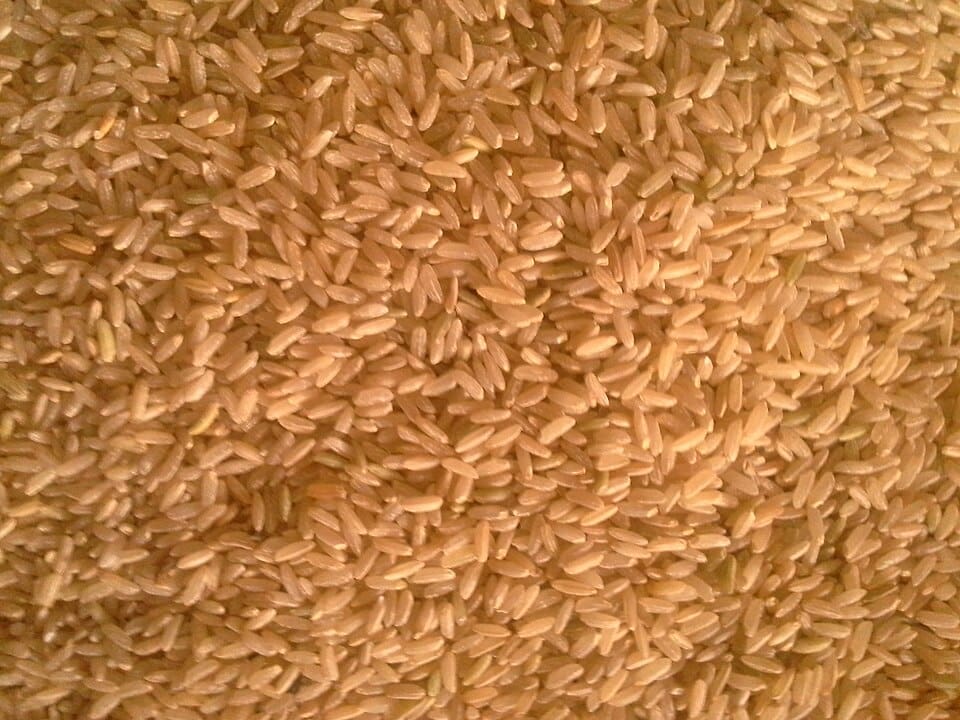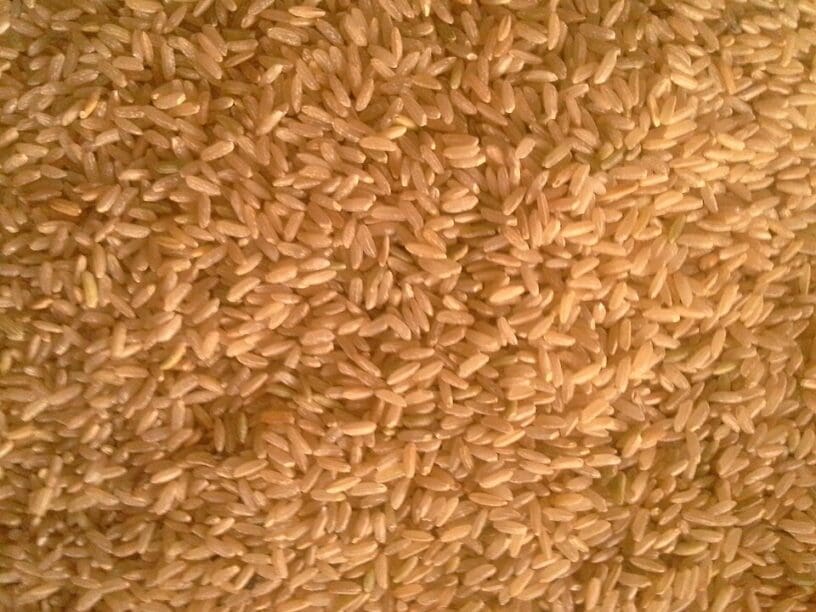20 Nutritional Facts About Brown Rice
When we talk of high-fiber nutritious food we can’t leave Brown rice behind. The rice contains valuable phytochemicals such as fiber, minerals, and amino acids among others.
Brown rice is a remarkable source of slow-release energy to sustain optimal body function throughout the day because it has a high content of carbohydrates. However, it is good to note people on low-carb diets should avoid brown rice.
In this article, we have showcased 20 nutritional facts about brown rice, journey with us as we discuss nutritious compounds found in brown rice and their importance to one’s body.
1. Brown Rice is Primarily a Source of Carbohydrates

Billjones94, CC BY-SA 4.0, via Wikimedia Commons
Brown rice is primarily made up of carbohydrates, including around 45 grams of carbohydrates per one-cup serving. The predominant type of carbohydrates present in this context mostly consists of complex carbs, notably starch. Complex carbohydrates have a slower rate of breakdown and digestion compared to simple sugars, hence offering a continuous and prolonged supply of energy.
The gradual release of energy provided by this mechanism aids in the maintenance of stable blood glucose levels, mitigating the abrupt surges and declines commonly observed following the consumption of high-sugar foods. Moreover, the dietary fiber present in brown rice, which amounts to around 3.5 grams per cup, provides additional benefits for gastrointestinal well-being and contributes to increased satiety.
Brown rice is well recognized as a dependable supply of carbohydrates, rendering it a nutritious option for sustaining energy levels. Consequently, it has become a fundamental component of numerous dietary practices across the globe.
2. Brown Rice is Low in Fat
Brown rice is characterized by its low-fat content since it contains less than 2 grams of total fat per one-cup portion. The low-fat level of this food makes it an attractive choice for persons who are interested in maintaining a heart-healthy diet or those who are looking to control their calorie consumption.
The inherent low-fat composition of brown rice renders it a very adaptable foundation for a multitude of culinary preparations, thereby facilitating the maintenance of a balanced fat intake. The aforementioned attribute, in conjunction with its additional nutritional advantages, contributes to the esteemed status of brown rice as a nourishing and comprehensive dietary option.
3. Brown Rice is a Good Source of Plant-Based Protein
Brown rice is considered to be an important source of plant-based protein as it offers an approximate protein content of 5 grams per one-cup serving. Although the protein content of plant-based foods may not be equivalent to that of animal products, it as well plays a significant role in meeting daily protein requirements, especially for individuals following vegetarian or vegan diets.
The protein found in brown rice is composed of essential amino acids. When combined with complementary proteins derived from other plant-based sources it helps assist individuals in fulfilling their protein needs.
4. It’s a Good Source of Various B Vitamins

ProjectManhattan, CC BY-SA 3.0, via Wikimedia Commons
Brown rice is considered to be a source of B vitamins, such as thiamin (B1), niacin (B3), and pyridoxine (B6). Thiamin plays an important role in the process of energy metabolism and the proper functioning of the nervous system while Niacin is known to maintain the health of the skin and digestive system.
Lastly, pyridoxine one of B Vitamins is involved in the development and functioning of the brain. Brown rice is a nutritional option with wide benefits since it incorporates B vitamins into one’s diet. These vitamins are integral to promoting general health and well-being.
5. Brown Rice is Rich in Minerals like Magnesium, Phosphorus, and Manganese
Brown rice is rich in critical minerals, including magnesium, phosphorus, and manganese. Magnesium is necessary for muscle and neuron function, bone health, and blood pressure management. Phosphorus plays a key part in bone and teeth health, and it promotes different cellular activities.
Manganese helps bone formation, enzyme function, and the metabolism of amino acids, cholesterol, and carbohydrates. Incorporating brown rice into your diet will help you meet your daily mineral needs, improving overall health and well-being.
6. Brown Rice Contains Iron
Iron is a vital element required for the synthesis of hemoglobin; a crucial protein found in erythrocytes that facilitates the transportation of oxygen across various bodily tissues. Brown rice contains iron and is estimated about one cup of brown rice provides around 1 milligram of iron hence serving as one of the iron sources.
It is good to note the iron content in brown rice is relatively lower compared to certain other food sources, however, it still serves as a valuable component of a well-rounded diet, especially for individuals seeking to sustain iron levels and reduce the risk of iron deficiency anemia.
7. Brown Rice Offers Some Copper, Which is Needed for the Formation of Red Blood Cells

Adityamadhav83, CC BY-SA 4.0, via Wikimedia Commons
Brown rice is known to possess a certain concentration of copper, which is an essential mineral that plays a role in maintaining human well-being. Copper serves as a cofactor for enzymes engaged in the manufacture of hemoglobin.
Consumption of a good amount of copper contributes to the enhancement of the immune system and aids in the preservation of optimal functionality of connective tissues, skeletal structures, and neural pathways. However, the copper level in brown rice may not be high but is helpful within the human body.
8. It Contains Trace Amounts of Zinc, Important for Immune System Support
Brown rice is known to contain small quantities of zinc, which is a vital component that plays a critical function in boosting the immune system. Zinc serves as a cofactor for numerous enzymes that play a crucial role in the immune response, while also contributing to the regulation of immune cell activity.
Although the zinc concentration in brown rice is very modest in relation to alternative sources, its inclusion in one’s diet can play a role in supporting the immune system and facilitating numerous physiological processes. Consequently, brown rice assumes significance as a constituent of a well-rounded and nutritionally balanced diet.
9. Brown Rice has a Lower Glycemic Index Compared to White Rice
Brown rice has a lower glycemic index (GI) compared to white rice, suggesting its slower impact on blood sugar levels. This is owing to its higher fiber content and fewer processed carbs.
The slow digestion and absorption of its complex carbs contribute to moderate increases in blood sugar, promoting better blood sugar regulation. Choosing brown rice over white rice may help lower the risk of blood sugar rises, making it a good choice for persons concerned about diabetes and overall glycemic control.
Get to know more about nutrition here.
10. Brown Rice Contains Magnesium which is Essential for Muscle Function
Magnesium has a crucial role in facilitating muscle functionality by supporting the processes of muscle contraction and relaxation, hence exhibiting a significant influence on physical activity and overall mobility.
In addition, magnesium plays an important role in promoting bone health through its contribution to enhancing bone density and strength. Insufficient levels of magnesium have been associated with the occurrence of muscle cramps, neurological problems, and compromised bone strength. It is important to add Brown rice to day-to-day meals for sufficient magnesium in our bodies.
Find Nutrition related article.
11. The Nutrients in Brown Rice Can Support Cognitive Function and Brain Health
Brown rice is known to provide a diverse array of nutrients that have the potential to enhance cognitive function and promote optimal brain health. B vitamins, such as thiamin, niacin, and pyridoxine, are known to have crucial functions in brain metabolism and the manufacture of neurotransmitters.
Also, the presence of magnesium in brown rice plays a crucial role in facilitating proper nerve activity and has been associated with cognitive well-being. The presence of antioxidants and phytonutrients in brown rice can safeguard brain cells against oxidative stress and inflammation, hence potentially mitigating the likelihood of cognitive decline and fostering overall brain health.
12. The Carbohydrates in Brown Rice Provide a Steady Source of Energy
The carbohydrates present in brown rice provide a reliable and enduring supply of energy. Complex carbohydrates are characterized by their ability to undergo slow digestion, resulting in a steady and sustained release of glucose into the bloodstream.
The consistent provision of energy aids in the maintenance of stable blood glucose levels, hence mitigating the occurrence of energy crashes commonly linked with the use of simple carbohydrates. It is a highly advantageous selection for maintaining consistent energy levels throughout the day, facilitating both physical and mental functions, and so serving as a crucial element of a well-rounded, energy-sustaining dietary regimen.
13. The Potassium Content Can Contribute to Regulating Blood Pressure
The presence of potassium in brown rice serves a significant function in the regulation of blood pressure. Potassium is a vital mineral that plays a crucial role in maintaining the homeostasis of salt levels inside the human body. Since it facilitates the elimination of sodium and inducing blood vessel dilation, it has the potential to reduce blood pressure levels.
The inclusion of potassium-rich foods, such as brown rice, has the potential to enhance the management of blood pressure, thereby diminishing the possibility of developing hypertension and its consequential health implications, such as heart disease and stroke.
14. The Fiber in Brown Rice Can Help Lower LDL (bad) Cholesterol Levels
Brown rice is known to have a fiber content of roughly 3.5 grams per cup, which has the potential to aid in the reduction of LDL (low-density lipoprotein) cholesterol levels. The presence of soluble fiber in brown rice facilitates the binding of cholesterol molecules, hence assisting in their excretion from the body.
This procedure has the potential to result in a decrease in the absorption of LDL cholesterol, hence providing support for cardiovascular well-being. Incorporating brown rice into a well-balanced diet can serve as a viable dietary approach for the management of cholesterol levels and the mitigation of cardiovascular disease risk.
Read more about nutrition in this article.
15. The Nutrients in Brown Rice, such as Fiber and Magnesium are Helpful
Brown rice contains several nutrients such as fiber and magnesium which helps in heart protection. Dietary fiber plays a key role in the reduction of cholesterol levels and the promotion of healthy blood pressure hence reducing the risk of developing heart disease.
Magnesium plays a role in facilitating heart function, hence contributing to the maintenance of a steady heartbeat and the promotion of vascular well-being. Adding brown rice to an individual’s nutritional diet can serve as a component of a heart-healthy eating plan.
16. The Fiber in Brown Rice Supports a Healthy Digestive System

Chouk Khmer, CC BY-SA 4.0, via Wikimedia Commons
Brown rice is high in dietary fiber, which benefits digestive health. This fiber thickens the stool, promoting regular bowel motions and reducing constipation.
It also promotes the formation of healthy gut bacteria, which may lessen the risk of illnesses such as diverticulitis. Furthermore, fiber can help with weight control and digestive well-being by increasing nutrient absorption and contributing to a feeling of fullness.
17. The Fiber in Brown Rice helps with Satiety and Weight Management
The fiber level found in brown rice, which is around 3.5 grams per cup, plays a crucial role in enhancing feelings of fullness and facilitating weight control.
Dietary fiber contributes to the volumetric aspect of meals, inducing satiety and promoting moderation in food consumption, hence potentially reducing excessive eating and facilitating calorie management.
Also, it decelerates the process of digestion, resulting in a prolonged release of energy and mitigating sudden changes in blood glucose levels.
18. It Contains Antioxidants
Brown rice is known to possess antioxidants, such as phenolic compounds and flavonoids, that play a crucial role in safeguarding cells against oxidative harm. Antioxidants possess the ability to fight harmful free radicals within the human body, thereby minimizing the risk of cellular harm and potential health diseases, including cancer.
Mixing brown rice into a well-balanced diet that includes foods abundant in antioxidants has the potential to boost the body’s ability to combat oxidative stress, thereby fostering general health and wellness, as well as mitigating the impact of aging and diverse chronic ailments.
19. Brown Rice is Naturally Gluten- Free

jules / stonesoup, CC BY 2.0, via Wikimedia Commons
Gluten is a protein found in wheat, barley, and rye, and ingesting it can induce severe effects in persons with gluten-related illnesses. Brown rice is a naturally gluten-free grain making it a safe and nutritious choice for persons with gluten sensitivities or celiac disease.
Brown rice is a perfect choice for persons following a gluten-free diet, helping an individual enjoy their meals without worrying about gluten-induced health risks.
20. Brown Rice is Naturally Low in Sodium
Brown rice is a good choice for persons on a reduced-sodium diet because it is naturally low in sodium. Excessive salt intake is harmful to our bodies and can contribute to high blood pressure and other health concerns.
Brown rice is one of the perfect choices since people can enjoy a nutrient-rich, tasty grain while limiting their sodium consumption. This automatically makes it a good alternative for anyone wishing to support heart health, maintain healthy blood pressure, and lower their risk of associated illnesses.
Brown rice has many advantages in one’s body compared to disadvantages. This rice contains many elements such as vitamins, and calcium, among others. Every nutritious element in brown rice has its own function and aids in the prevention of harmful pathogens hence reducing health risks.
Planning a trip to Paris ? Get ready !
These are Amazon’s best-selling travel products that you may need for coming to Paris.
Bookstore
- The best travel book : Rick Steves – Paris 2023 – Learn more here
- Fodor’s Paris 2024 – Learn more here
Travel Gear
- Venture Pal Lightweight Backpack – Learn more here
- Samsonite Winfield 2 28″ Luggage – Learn more here
- Swig Savvy’s Stainless Steel Insulated Water Bottle – Learn more here
Check Amazon’s best-seller list for the most popular travel accessories. We sometimes read this list just to find out what new travel products people are buying.











